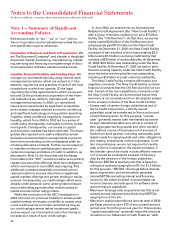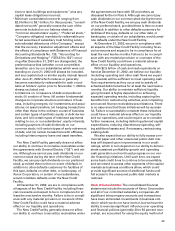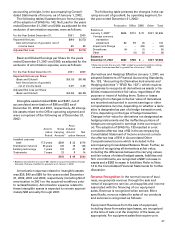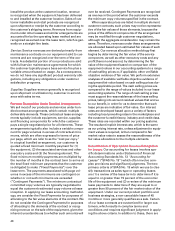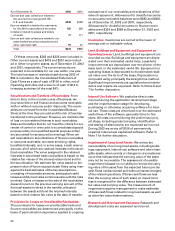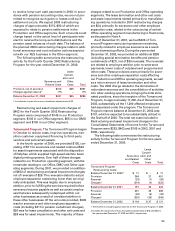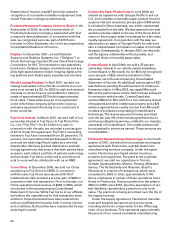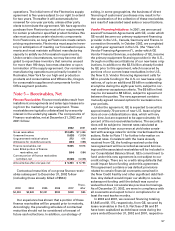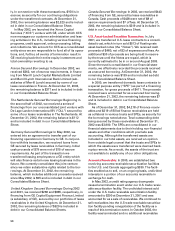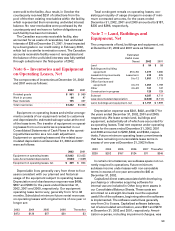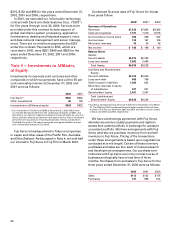Xerox 2002 Annual Report Download - page 53
Download and view the complete annual report
Please find page 53 of the 2002 Xerox annual report below. You can navigate through the pages in the report by either clicking on the pages listed below, or by using the keyword search tool below to find specific information within the annual report.
51
cost over the remaining service lives of the employ-
ees participating in the pension plan.
An additional significant assumption affecting our
pension and post-retirement benefit obligations and
the net periodic pension and other post-retirement
benefit cost is the rate that we use to discount our
future anticipated benefit obligations. In estimating
this rate, we consider rates of return on high quality
fixed-income investments currently available, and
expected to be available, during the period to maturi-
ty of the pension benefits.
Foreign Currency Translation: The functional currency
for most foreign operations is the local currency. Net
assets are translated at current rates of exchange,
and income, expense and cash flow items are trans-
lated at the average exchange rate for the year. The
translation adjustments are recorded in Accumulated
Other Comprehensive Income. The U.S. dollar is
used as the functional currency for certain sub-
sidiaries that conduct their business in U.S. dollars or
operate in hyperinflationary economies. A combina-
tion of current and historical exchange rates is used in
remeasuring the local currency transactions of these
subsidiaries, and the resulting exchange adjustments
are included in income. Aggregate foreign currency
losses were $77 in 2002 and gains were $29 and
$103 in 2001 and 2000, respectively, and are included
in Other expenses, net in the accompanying Con-
solidated Statements of Income. Effective January 1,
2002, we changed the functional currency of our
Argentina operation from the U.S. dollar to the Peso
as a result of operational changes made subsequent
to the government’s new economic plan.
Note 2 — Restructuring Programs
Since early 2000, we have engaged in a series of
restructuring programs related to downsizing our
employee base, exiting certain businesses, outsourcing
certain internal functions and engaging in other
actions designed to reduce our cost structure. We
accomplished these objectives through the undertak-
ing of restructuring initiatives, two of which, the SOHO
Disengagement and the March 2000 Restructuring, are
now substantially completed. The execution of the
Turnaround Program and the Fourth Quarter 2002
Restructuring Program and related payments of obliga-
tions continued through December 31, 2002. As man-
agement continues to evaluate the business, there may
be supplemental charges for new plan initiatives as
well as changes in estimates to amounts previously
recorded, as payments are made or actions are com-
pleted. Asset impairment charges were incurred in con-
nection with these restructuring actions for those
assets made obsolete or redundant as a result of the
plans. The restructuring and asset impairment charges
Pension and Post-Retirement Benefit Obligations: We
sponsor pension plans in various forms and in vari-
ous countries covering substantially all employees
who meet certain eligibility requirements. Post-retire-
ment benefit plans cover primarily U.S. employees for
retirement medical costs. As required by existing
accounting rules, we employ a delayed recognition
feature in measuring the costs and obligations of pen-
sion and post-retirement benefit plans. This allows for
changes in the benefit obligations and changes in the
value of assets set aside to meet those obligations to
be recognized, not as they occur, but systematically
and gradually over subsequent periods. All changes
are ultimately recognized, except to the extent they
may be offset by subsequent changes. At any point,
changes that have been identified and quantified
await subsequent accounting recognition as net cost
components and as liabilities or assets.
Several statistical and other factors that attempt to
anticipate future events are used in calculating the
expense, liability and asset values related to our
pension and post-retirement benefit plans. These
factors include assumptions we make about the dis-
count rate, expected return on plan assets, rate of
increase in healthcare costs, the rate of future com-
pensation increases, and mortality, among others.
Actual returns on plan assets are not immediately
recognized in our income statement, due to the afore-
mentioned delayed recognition feature that we follow
in accounting for pensions. In calculating the expect-
ed return on the plan asset component of our net
periodic pension cost, we apply our estimate of the
long-term rate of return to the plan assets that
support our pension obligations, after deducting
assets that are specifically allocated to Transitional
Retirement Accounts (which are accounted for based
on specific plan terms).
For purposes of determining the expected return
on plan assets, we utilize a calculated value approach
in determining the value of the pension plan assets,
as opposed to a fair market value approach. The pri-
mary difference between the two methods relates to
systematic recognition of changes in fair value over
time (generally two years) versus immediate recogni-
tion of changes in fair value. Our expected rate of
return on plan assets is then applied to the calculated
asset value to determine the amount of the expected
return on plan assets to be used in the determination
of the net periodic pension cost. The calculated value
approach reduces the volatility in net periodic pension
cost that results from using the fair market value
approach.
The difference between the actual return on plan
assets and the expected return on plan assets is
added to, or subtracted from, any cumulative differ-
ences that arose in prior years. This amount is a com-
ponent of the unrecognized net actuarial (gain) loss
and is subject to amortization of net periodic pension



